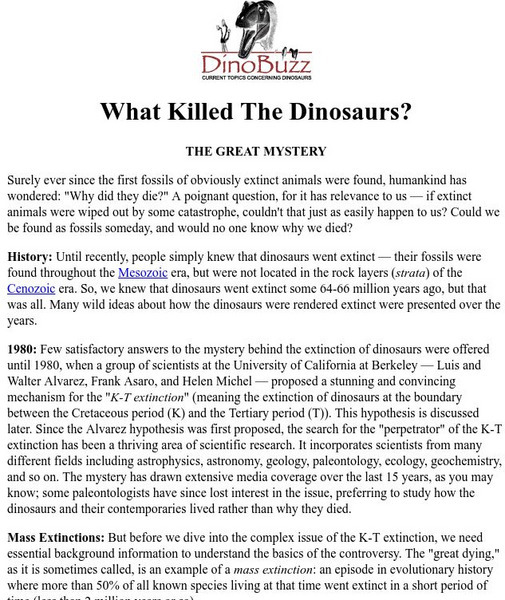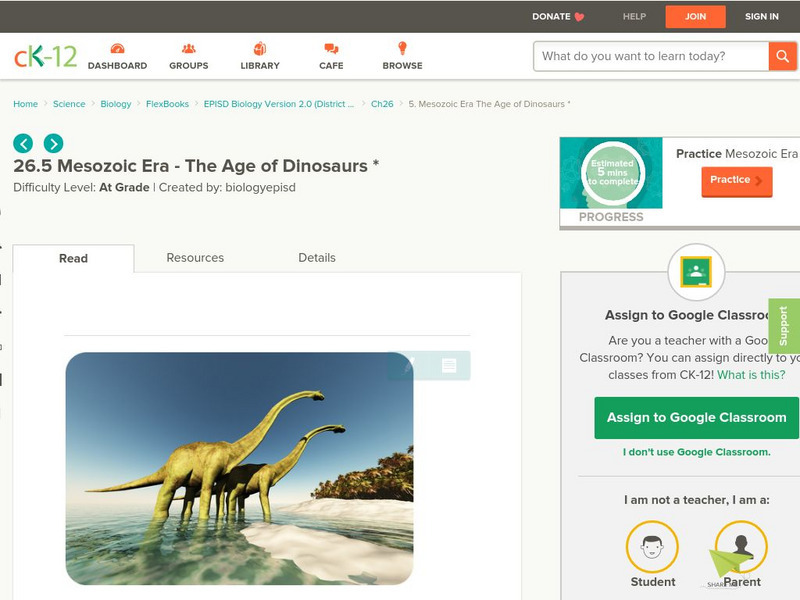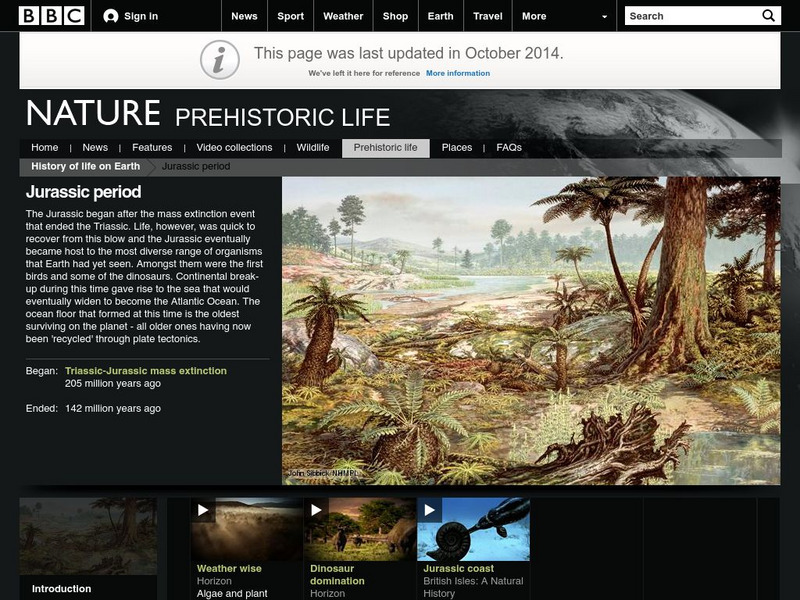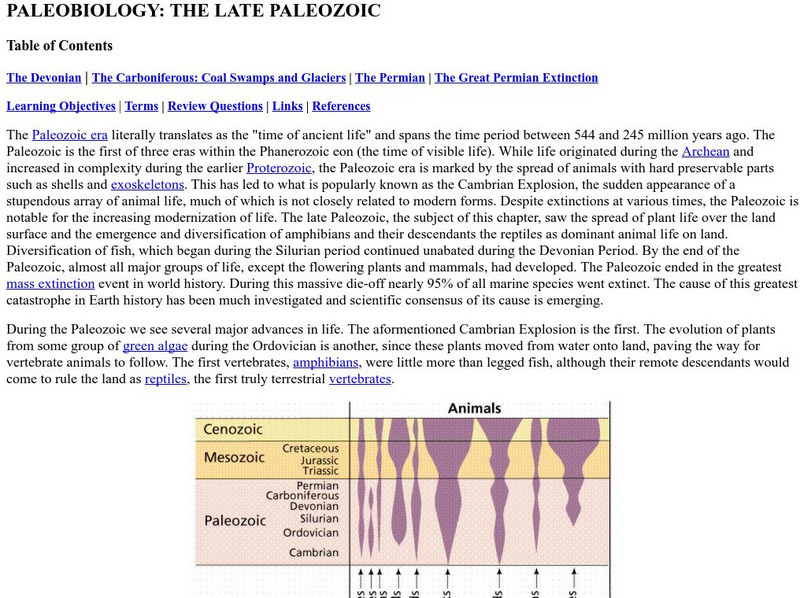Howard Hughes Medical Institute
EarthViewer
Can you imagine Washington DC and London as close neighbors occupying the same continent? Learners will be fascinated as they step back in time and discover the evolution of the earth's continents and oceans from 4.5 billion...
American Museum of Natural History
Living Large
Get to know all about sauropods from a paleontologist, Jonah. Following an introductory video, scholars choose from five fossils to learn more about. Each fossil begins with a video, provides information from several different...
NOAA
Climate Is Our Friend…Isn’t It?: Make an Extinction Polyhedron
Climate affects populations in different ways. Scholars research extinct organisms and mass extinctions in part three of the 10-installment Discover Your Changing World series. They create graphic organizers, then fill in the...
Howard Hughes Medical Institute
Weighing the Evidence for a Mass Extinction Part 2: On Land
What can fossils tell us about periods of extinction? Young scholars interpret fossil layers to make conclusions about changes in life during different geological time periods. They analyze the fossils for abundance and diversity as well...
Howard Hughes Medical Institute
Finding the Crater
A mass extinction event caused by an impact usually leaves a crater. Scholars use data from 10 different sites around the world trying to determine where to look for the crater. They use data, listing the amount of various minerals to...
Howard Hughes Medical Institute
Weighing the Evidence for a Mass Extinction: Part 1 – In the Ocean
Extinction events have happen throughout geologic history, but only five mass extinctions occurred over the last 4.5 billion years. Scholars view fossils from a layer of sediment during an extinction event and observe patterns to draw...
Edinburgh UNESCO City of Literature Trust
The Lost World
Fans of Sherlock Holmes may be surprised to learn that in addition to stories of the famous deductionist, Sir Arthur Conan Doyle is also the creator of Professor Challenger. An irascible, unpredictable scientist, Challenger was featured...
Howard Hughes Medical Institute
Mass Extinctions Interactive
Extinctions constantly occur, but what sets off a mass extinction event? Young scientists study the data from the previous five mass extinctions to better understand their causes. Then, they learn the impact each extinction had on our...
Howard Hughes Medical Institute
EarthViewer
Almost complete annihilation of the plants and animals on the Earth has occurred at least five times in the past. Young scientists explore each of these events. They learn about the evidence and conclusions for each event and connect...
Howard Hughes Medical Institute
The Day the Mesozoic Died
While this is not the traditional, step-by-step lesson plan, it is chock-full of material that you can easily incorporate into your earth history unit. Its main purpose is to serve as a guide to using a three-part film, The Day the...
Curated OER
AP: Chapter 25: Phylogeny and Systematics
As a review or note taking guide, this resource wraps up a unit on the tree of life. Biology bigwigs define phylogeny and answer questions about the subsequent classification of organisms. The worksheet takes a straightforward and...
Curated OER
History of Life
In this history of life worksheet, students will explore how mass extinctions have occurred on Earth, the different periods of the geological time scale, and scientists' use of fossil records. Students will complete 3 fill in the blank...
Curated OER
ARE WE IN THE MIDDLE OF A MASS EXTINCTION?
Middle schoolers identify and interpret the following: What is mass extinction, and what are some theories for why it happens? How often do species become extinct? What is the normal rate of extinction? Why are some species...
University of California
Ucmp: What Killed the Dinosaurs?
This UC Berkeley site extensively covers the death of the dinosaurs. It includes history, theories, invalid hypotheses, and current arguments.
CK-12 Foundation
Ck 12: Episd: Mesozoic Era the Age of Dinosaurs
[Free Registration/Login may be required to access all resource tools.] Explore the three periods of the Mesozoic Era, the age when dinosaurs roamed the earth. Find out what happened to the dinosaurs.
Science Education Resource Center at Carleton College
Serc: Extinction: Is It Inevitable?
Students read the article "The Sixth Extinction" by Niles Eldredge on past mass extinctions and the current rate of loss of species. There is a choice of student activities which includes having students respond to discussion and...
BBC
Bbc Nature: Prehistoric Life: Jurassic Period
Overview of the Earth in the Jurassic Period told by photos, news, videos, and external links with emphasis on what grew then, what lived then, the causes of mass extinction, types of fossils, and what life was like in general.
BBC
Bbc Nature: Prehistoric Life: Triassic Period
Overview of the Earth in the Triassic Period as told by photos, news, and external links with an emphasis on what grew then, what lived then, the causes of mass extinction, types of fossils, and what life was like in general.
BBC
Bbc Nature: Prehistoric Life
Explore life on ancient Earth with this site! Students can walk with dinosaurs to see what Earth looked like or investigate Earth's history. The site includes articles, pictures, timelines, and lots more.
Lawrence Berkeley National Laboratory
Berkeley Lab: The Fruitful & Inventive Mind of Scientist Luis Alvarez
This article, reprinted from the fall 1979 LBL News Magazine, was written about Dr. Luis Alvarez and his part in the study of geological sediments and the great extinctions.
San Diego Natural History Museum
San Diego Natural History Museum: Dinosaur Dig
The San Diego Natural History Museum provides dinosaur lovers with plenty of information and fun facts with links to Finding Fossils and Dinosaur Bytes.
Estrella Mountain Community College
Online Biology Book: Paleobiology: The Late Paleozoic
College-level biology book covers the Late Paleozoic geologic time period in Earth's history. See photographs of fossil evidence from that era in addition to diagrams to help with understanding.
Other
Hvpm: Mass Extinctions
An overview of the mass extinctions throughout earth history. Each mass extinction has a link to its own page with a list of its possible causes and the species that were most affected.
Georgia Department of Education
Ga Virtual Learning: Historical Geology
In this interactive tutorial you will explore how geologists use clues in rocks to determine the order in which rocks formed. Learn how principles of radioactivity are used to assign actual ages to rocks. Students will explore fossils...























